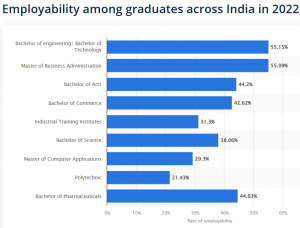
The Indian education system is large and diverse as serves a population of over 1.3 billion people. While the system has made significant progress in terms of quality and accessibility in recent years, the problem of unemployability has not been addressed adequately. The country’s education system is plagued by several problems that it needs an urgent rehaul to suit the requirements of the second largest population in the world. A targeted effort is also needed to employ those who manage to get an education in a largely tangled system.
India has over 1,000 universities, 42,000 colleges and over 11,500 stand-alone institutes, making the education system the third largest in the world. The country’s education system has seen tremendous growth since independence, but lags behind the best in the world. The return on investment made on education has been pathetically low and students are not skilled enough despite getting years of education.
The improvement in education is an urgent need as India desires to become a global economic powerhouse. To achieve this, building intellectual and social capital within the country and fostering knowledge, capability and expertise that must be a priority.
READ | Indian economy shines amid global crisis, but can it emulate China?
A study by ASSOCHAM in 2016 revealed that only 7% of the MBA graduates churned out by the country’s 5,500 B-Schools were employable. The National Employability Report for Engineers 2019 put out by a job assessment platform also showed that over 80% of engineers in India were unfit to take up any job in the knowledge economy. According to the World Economic Forum, just one in every four management professionals, one in every five engineers, and one in every 10 graduates in India are employable.
Employability among graduates across India in 2022

Recent changes in educational system
The Union government introduced the National Education Policy (NEP 2020) to bring drastic changes to the existing education system. It made sweeping changes in the National Education Policy and the draft was shared in 2020. The NEP 2020 promises to overhaul the existing school and university system with a liberal approach and a bold vision. Along with the policy, the government plans to increase investment in education to 6% of the GDP and to boost enrolment in higher education by 50%. The plan is to add 3.5 crore seats in colleges and universities.
The schools will follow a new 5+3+3+4 format which translates into 5-year foundational school, 3-year preparatory school, 3-year middle school and 4-year secondary school. NEP 2020 has set a target of increasing the current higher education GER from nearly 27% to 50% by 2035. Therefore, along with an aim to improve on staff and infrastructure parameters, the higher education system needs to add an additional capacity of about 34 million students by 2035, says a recent report by FICCI and EY.
What plagues the Indian education system
One challenge facing the education system is the quality of education. Despite improvements in literacy rates, there are still concerns about the quality and suitability of teaching and learning, particularly in rural and underprivileged areas. There is also a significant gap in the quality of education between private and public schools, with private schools often providing not just better education but also a better scope for clearing college admission tests.
Another issue is the focus on rote learning and memorisation rather than critical thinking and problem-solving skills. This approach to education can lead to a lack of creativity and innovation, and may not adequately prepare students for the demands of the modern job market. In addition, there is a lack of resources and infrastructure in many schools, particularly in rural areas. This can impact the quality of education and make it difficult for students to learn effectively. The gender gap in access to education is another issue that needs to be addressed.
Then there is the question of employability. Issues related to job availability, job quality, and wage stagnation also continue to haunt the job market.
One challenge facing the Indian job market is the availability of good jobs. While the country has a large and growing economy, many jobs are low-paying and lack benefits, and there is a lack of high-skilled jobs in certain sectors. This can make it difficult for workers to find good-quality employment that provides a stable income and opportunities for advancement.
Another issue is wage stagnation. Despite economic growth, wages for many workers have not kept pace, particularly in low-skilled and informal sectors. This can make it difficult for workers to make ends meet and improve their standard of living. This has also led to brain-led as a plethora of Indian diaspora leaves in search for better paying jobs, thus leaving the nation deprived of talent at home.
Additionally, the Indian job market is facing challenges related to automation and technology, which are changing the nature of work and the skills that are in demand. This can create uncertainty for workers as they try to adapt to these changes and stay competitive in the job market.
India needs to benefit from its demographic dividend as the country has 65% of its youth in the working age group. While the number of graduates is also satisfactory, employability remains a sour point. Businesses and industries are disappointed with the graduates lacking the right kind of employability skills. According to analysts, a pragmatic approach is to integrate vocational education with general education in colleges. Colleges must also focus in skilling, re-skilling and upskilling.
